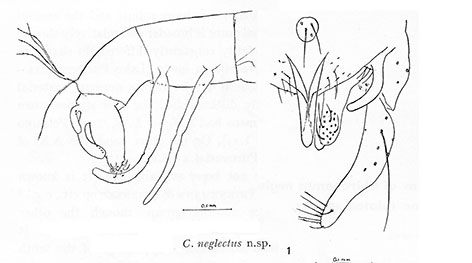Species 4e. C. jonmartini Lindeberg and Wiederholm 1979, sensu Kiknadze et al., 1996bA member of the Chironomus aberratus species group. There are two specimens, from Iceland, listed in the BOLD database but they lack DNA sequence and so are not allocated to a BOLD Bin. Adult: (from Lindeberg's (1960) description of his C. neglectus from Finland and from Lindeberg & Wiederholm (1979 redescription) Entirely black, sometimes with legs and scutellum paler, posterior margins of tergites often greyish, haltere knob dirty white. Frontal tubercles well developed (greater than 30 µm long) Fore leg proportions: 35 : 34 : 43 : 22 : 15 : 12 : 6, LR 1.18-1.38; F/T 1.03: BR 4.5-7. Illustration shows 4 setae in a single spot on tergite IX. Anal point slender and parallel sided or tapered. Superior volsella an E-type, clostest to 'g' of Strenzke (1959), but ending bluntly. Inferior volsella reaching to end of anal point (abt 1/3 of gonostylus length) with recurved setae only on apical half; gonostylus only moderately swollen and narrowing relatively gently over distal third.  Larva and male hypopygium of C. jonmartini from Lindeberg 1960 Female: No available information. Pupa: (from Langton & Visser 2003): Length 7.6-9.4 mm (9.0-11.0 mm in Finland). Contrast in color between thorax and abdomen not so marked; outer margin of anal lobes colored except at base. Fourth instar larva of melanotus-type (Lindeberg calls larva a plumosus-type, although his illustration (above) shows ventral tubules do not show the 'plumosus-type' bending and coiling). Head with dark gular region and dark head stripe on the frontoclypeus. Mentum with 4th laterals reduced almost to level of 5th laterals (type II), C1 tooth of mentum moderately wide with c2 teeth moderately separated (type IB). Cytology: 4 polytene chromosomes with the thummi-cytocomplex arm combination (AB, CD, EF, G). Centromeres heterochromatic. h'jon B1: 1 - 7, 8b - 15, 22 - 28 - according to Hirvenoja & Michailova (1997), but this leaves many bands unaccounted for. h'jon C1: 1 - 6b, 11 - 8, 15 - 11d, 6gh, 17a - 16, 7d-a, 6f-c, 17b - 22 according to Kiknadze et al. 2004, 2016 h'jon D1: 1 - 3, 11 - 18d, 7 - 4, 10 - 8, 18e - 24 i.e. as Kiknadze et al. 2004, 2016. h'jon E1: 1 - 3e, 5 - 10b, 4 - 3f, 10c - 13 i.e. as aberratus, plumosus etc., E1, h'jon F1: 1 - 10, 17 - 11, 18 - 23 i.e. as cucini, tenuistylus, etc. h'jon F3: 1 - 2, 5 - 3, 6 - 10, 17 - 11, 18 - 23 from Kiknadze et al. 1996b Found: North West Territories – tundra pond FBV, Horton river area (M.G.Butler) C. jonmartini was proposed by Lindeberg & Wiederholm as a new name for C. neglectus Lindeberg. It is not certain that the present material is identical to that of Lindeberg & Wiederholm, which was partly cytologically described by Wülker (1973, 1991b) as arm G may differ. However, studies from other parts of the Palearctic indicate that the larval morphology and chromosomal banding patterns are variable (Kiknadze et al. 1996b & 2016, Rakisheva et al. 2001). The North American material seems to be identical to that described by Kiknadze et al. (1996b) and most of the larval description above is based on their description. |
Modified: 6 May 2021
Access: Unrestricted
Copyright © 2000-2021, Jon Martin.